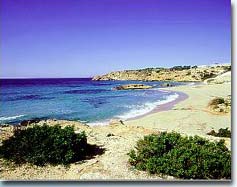 |
 |
 |
 |
 |
 |
 |
 |
 |
 |
 |
 |
|
In cooperation with Universitat |
A Small Big World
IBIZA, the island, is the third largest of the Balearic Islands and together with Formentera forms the "Pitiusas" islands, that is what the Greeks called them, and it means "islands of pine trees". The population is 80.000 inhabitants and the island enjoys an excellent climate with an average annual temperature of 21,5° C maximum and 14° C minimum.
Ibiza, on the sun route of the ancient Phoenicians, is situated in The western Mediterranean. It has an extension of 572 square kms and a coastline of 210 kms. Its highest elevation is s'Atalaiassa (475 metres) and in The waters which surround the island there are a total of 48 smaller islands, some of which, such as sa Conillera (7,29 square kms) are in themselves a small world. In reality the whole of the island is a small big world extending from the coast to the interior, its surface generally hilly and mountainous, and offers all sorts of contrasts which instil in the visitor an adventurous spirit, so that the might discover an interest in culture, tradition, nature or art.
The history of Ibiza has its beginnings in 1600 BC, however, there are no chronological records until 654 BC, when Carthage founded lbosim, nowadays Eivissa, the capital of the island, and it was Diodoro Sículo who was the first to mention us
".. After the afore -mentioned island (Sardinia) lies the so-called Pitiusa, which carries this name because of the great number of pine trees wbich grow on it...".The Carthaginians of ibiza came from Phoenicia and were very good traders. They were followed by the Romans under whom Ibiza received the title of Confederated City. In the following five centuries, know as the "dark centuries" because very little is known about them, ruled the Barbarians and the Byzantines, and their rule ended in the year 711 when the Arabs arrived and with them the name "Yebisah" for the island. The key Catalonian conquest took place, an act with wich the islands Ibiza and Formentera became part of what we nowadays call "western world". In this short historical résumé it must also be mentioned that for centuries Ibiza was attacked by Saracens who, under the protection of Turkish squadrons, made the Mediterranean unsafe. From this epoch stem the fortified rural churches and the watch towers that surround the island.
The island of Ibiza consists of five municipalities: Eivissa, the capital; Santa Eulària, Sant Antoni, Sant Josep and Sant Joan. To the visitor each one of these offers distinct possibilities which complement each other. In Ibiza a small big world opens itself to the visitor and keeps him, if he so wishes, busy for twenty-four hours a day.
More About Ibiza



